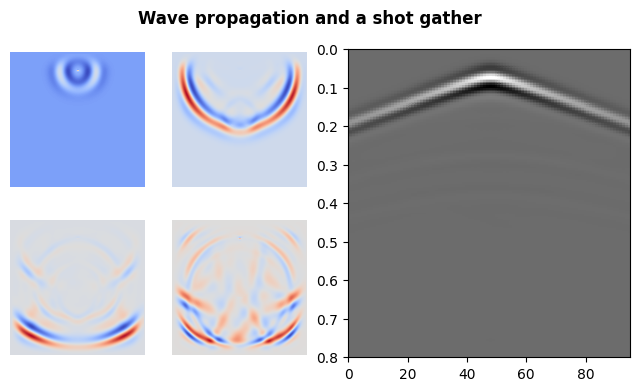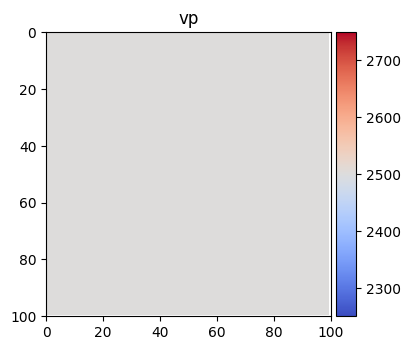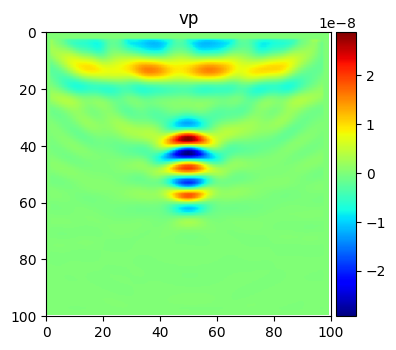Installation
PyFWI can be installed using pip as
(.venv) $ pip install PyFWI
on macOS or
(.venv) $ py -m pip install PyFWI
on Windows.
Simple Gradient Computation
In this section we see some applications of PyFWI. First, forward modeling is shown and then we estimate gradient of cost funtion with respect to \(V_P\).
1. Forward modeling
In this simple example, we use PyFWI to do forward modeling. So, we need to first import the following packages amd modulus.
import matplotlib.pyplot as plt
import numpy as np
import PyFWI.wave_propagation as wave
import PyFWI.acquisition as acq
import PyFWI.seiplot as splt
import PyFWI.model_dataset as md
import PyFWI.fwi_tools as tools
import PyFWI.processing as process
A simple model can be created by using model_dataset module as
Model = md.ModelGenerator('louboutin')
model = Model()
im = splt.earth_model(model, cmap='coolwarm')

Then we need to create an input dictionary as follow
model_shape = model[[*model][0]].shape
inpa = {
'ns': 1, # Number of sources
'sdo': 4, # Order of FD
'fdom': 15, # Central frequency of source
'dh': 7, # Spatial sampling rate
'dt': 0.004, # Temporal sampling rate
'acq_type': 1, # Type of acquisition (0: crosswell, 1: surface, 2: both)
't': 0.8, # Length of operation
'npml': 20, # Number of PML
'pmlR': 1e-5, # Coefficient for PML (No need to change)
'pml_dir': 2, # type of boundary layer
'device': 1, # The device to run the program. Usually 0: CPU 1: GPU
}
seisout = 0 # Type of output 0: Pressure
inpa['rec_dis'] = 1 * inpa['dh'] # Define the receivers' distance
Now, we obtain the location of sources and receivers based on specified parameters.
offsetx = inpa['dh'] * model_shape[1]
depth = inpa['dh'] * model_shape[0]
src_loc, rec_loc = acq.surface_seismic(inpa['ns'], inpa['rec_dis'], offsetx,
inpa['dh'], inpa['sdo'])
src_loc[:, 1] -= 5 * inpa['dh']
# Create the source
src = acq.Source(src_loc, inpa['dh'], inpa['dt'])
src.Ricker(inpa['fdom'])
Finally, we can have the forward modelling as
# Create the wave object
W = wave.WavePropagator(inpa, src, rec_loc, model_shape, components=seisout, chpr=20)
# Call the forward modelling
d_obs = W.forward_modeling(model, show=False) # show=True can show the propagation of the wave
To compute the gradient using the adjoint-state method, we need to save the wavefield during the forward wave propagation. This must be done for the wavefield obtained from estimated model. For example, the wavefield at four time steps are presented here in addition to a shot gather.
fig = plt.figure(figsize=(8, 4))
count = 1
ax = fig.add_subplot(122)
ax = splt.seismic_section(ax, d_obs['taux'], t_axis=np.linspace(0, inpa['t'], int(1 + inpa['t'] // inpa['dt'])))
ax_loc = [1, 2, 5, 6]
snapshots = [40, 80, 130, 180]
for i in range(len(snapshots)):
ax = fig.add_subplot(2, 4, ax_loc[i])
ax.imshow(W.W['taux'][:, :, 0, snapshots[i]], cmap='coolwarm')
ax.axis('off')
count += 1
fig.suptitle("Wave propagation and a shot gather", fontweight='bold');

2. Gradient
To compute the gradient, we need the observed data and an initial model. So, first we obtain the observed data using more sources.
Note: For better visualization and avoiding crosstalk, I compute the gradient in acoustic media.
# Making medium acoustic
model['vs'] *= 0.0
model['rho'] = np.ones_like(model['rho'])
# Increasing number of sources
inpa['ns'] = 5
src_loc, rec_loc = acq.surface_seismic(inpa['ns'], inpa['rec_dis'], offsetx,
inpa['dh'], inpa['sdo'])
src_loc[:, 1] -= 5 * inpa['dh']
# Create the source
src = acq.Source(src_loc, inpa['dh'], inpa['dt'])
src.Ricker(inpa['fdom'])
# Create the wave object
W = wave.WavePropagator(inpa, src, rec_loc, model_shape, components=seisout, chpr=20)
# Call the forward modelling
db_obs = W.forward_modeling(model, show=False) # show=True can show the propagation of the wave
# preparing data amd applying gain if required
db_obs = process.prepare_residual(db_obs, 1)
Then we create the initial model.
m0 = Model(smoothing=1)
m0['vs'] *= 0.0
m0['rho'] = np.ones_like(model['rho'])
im = splt.earth_model(m0, ['vp'], cmap='coolwarm')

And we simulate the wave propagation to obtain estimated data. For
computing the gradient, we can smooth the gradient and scale it by
defining g_smooth and energy_balancing.
inpa['energy_balancing'] = True
We save the wavefield at 20% of the time steps (chpr = 20) to be
used for gradient calculation. The value of wavefield is accessible
using the attribute W which is a dictionary for \(V_x\),
\(V_z\), \(\tau_x\), \(\tau_z\), and \(\tau_{xz}\) as
vx, vz, taux, tauz, and tauxz. Each parameter is a
4D tensor. For example, we can have access to the last time step of
\(\tau_x\) for the first shot as W.W['taux'][:, :, 0, -1].
Lam = wave.WavePropagator(inpa, src, rec_loc, model_shape,
chpr=20, components=seisout)
d_est = Lam.forward_modeling(m0, False)
d_est = process.prepare_residual(d_est, 1)
Now, we define the cost function and obtaine the residuals for adjoint-state method.
CF = tools.CostFunction('l2')
rms, adj_src = tools.cost_seismic(d_est, db_obs, fun=CF)
# print(rms)
Using the adjoint source, we can estimate the gradient as
grad = Lam.gradient(adj_src, show=False)
# Time to plot the results
splt.earth_model(grad, ['vp'], cmap='jet');
